Bringing a product to market in 2024 is brutal: You’re reaching out to busy prospects who get 37 messages each day just like yours - aka, they probably won’t read your message. And even if they did and were interested in your product, getting the budget approved would subject them to interrogations they can live without.
When everyone’s competing for attention, nobody wins. The state of go-to-market is in a vicious cycle: Marketing and sales get harder, which makes everyone do more outreach, which makes prospects less likely to engage, which makes marketing and sales harder.
Universal frustration is one of the hallmark signs of a great opportunity to launch a startup in a space. And it's even better if that space is close to revenue: It's easier to sell a product if it directly makes (or saves) your customer money.
Nothing checks that box better than tech built for revenue teams. That's why we spoke with founders and leaders at RevTech startups Keyplay, Myko AI, Rattle, Unify, and Default.
We chatted with them about how GTM is changing, the solution they built and how they’re using their own products to improve the GTM landscape better.
Here’s what we found:
Where GTM went wrong (and how it’ll get better)
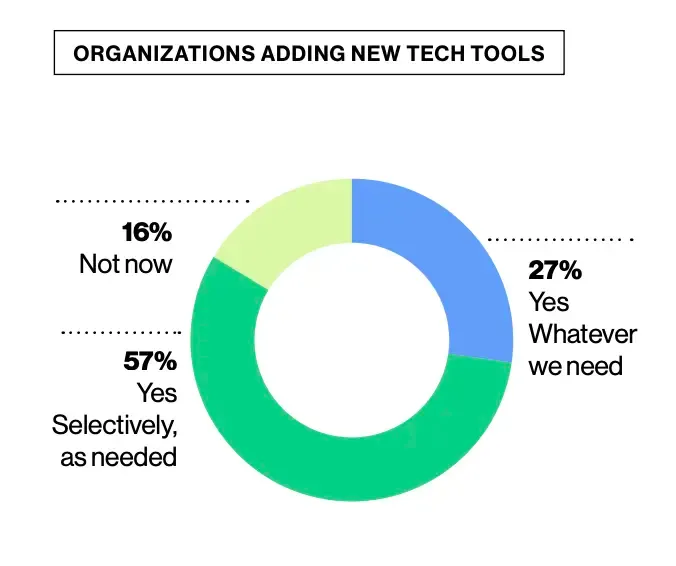
Companies are consolidating spending and are more hesitant to buy new tools. According to a survey run by Rattle, 57% of orgs are super picky over what they’re buying, and 15% percent have a total embargo on tech buys. Even if there is budget, buyers are frustrated for a few reasons.
Inundation: What does everyone want from me?
The first is inundation - there are so many channels that sellers can reach out to buyers through - LinkedIn, text, cold call, email, etc. Theoretically, if messages are relevant and timing aligns, outreach is useful to solve a problem. But in practice, most people get irrelevant, annoying outreach messages.
As Unify’s founder/CEO Austin Hughes told us: “People are just inundated by noise and volume of communication, and it’s not just email - it’s texts, push notifications, it’s marketing emails from every product you’ve ever bought. We as consumers are getting more and more desensitized to those sorts of interactions. It just makes it even more important that what you send to people has to be relevant, personalized to them, and valuable,”
Spray and pray sales
The biggest reason we’re inundated with random crap is because of “spray and pray” selling: Reps reach out to anyone remotely relevant to hope that their message lands.
Default’s Nico Ferreyra said it best, “Outbound has definitely become harder – commoditization of B2B contact and intent data, decreasing mass email deliverability, and the advent of AI-powered copywriting solutions are all headwinds to building scalable outbound-driven revenue engines. We believe the future of sales is more consultative than transactional – i.e. sales reps knowing how and when to engage in the buyer journey as opposed to being an obstacle to delivering value to customers (as they are in many orgs).”
Lack of clarity
Contributing to this problem is a lack of clear intent data - sellers are reaching out to anyone because they don’t know who’s interested. Are prospects visiting their website (or their competitor’s)? Are they googling “how to solve x” or reading articles relevant to a product? If you don’t know who to reach out to, better reach out to everyone.
But revenue teams often lack the flexibility to adjust their ICPs and addressable markets or find enough accounts that fit them. If you change your target market in a pivot, you need to adapt your go-to-market motion quickly.
Too much data
Sellers produce a shitton of data, from emails to LinkedIn messages, call recordings, contract negotiations and terms, etc. Keeping everything in the right place is hard enough. Making it useful is even harder (and happens even more rarely).

Because there’s so much data, no one is actually doing anything about it. Sales reps hate admin tasks like updating the CRM. On the flip side, reps are often questioned about their deal statuses, and deals can go from Closed Won to Closed Lost without support from leadership.
Why go-to-market needs to change
Here’s the thing: Software companies need to sell to keep growing. Sales isn’t going away.
This is why the sales process absolutely needs to change. Companies like Keyplay, Myko AI, Unify, Default, and Rattle are using tools like AI to actively evolve the GTM sales motion and make it easier for sellers to break through the noise.
Finding the right types of accounts to reach out to is imperative - instead of scrolling LinkedIn and hoping you hit gold on a good account, Keyplay helps you figure out what’s important to you and find matches for good customers - this saves time and energy for reps and GTM strategists and shows you the data behind why it thinks they’d be a good match.
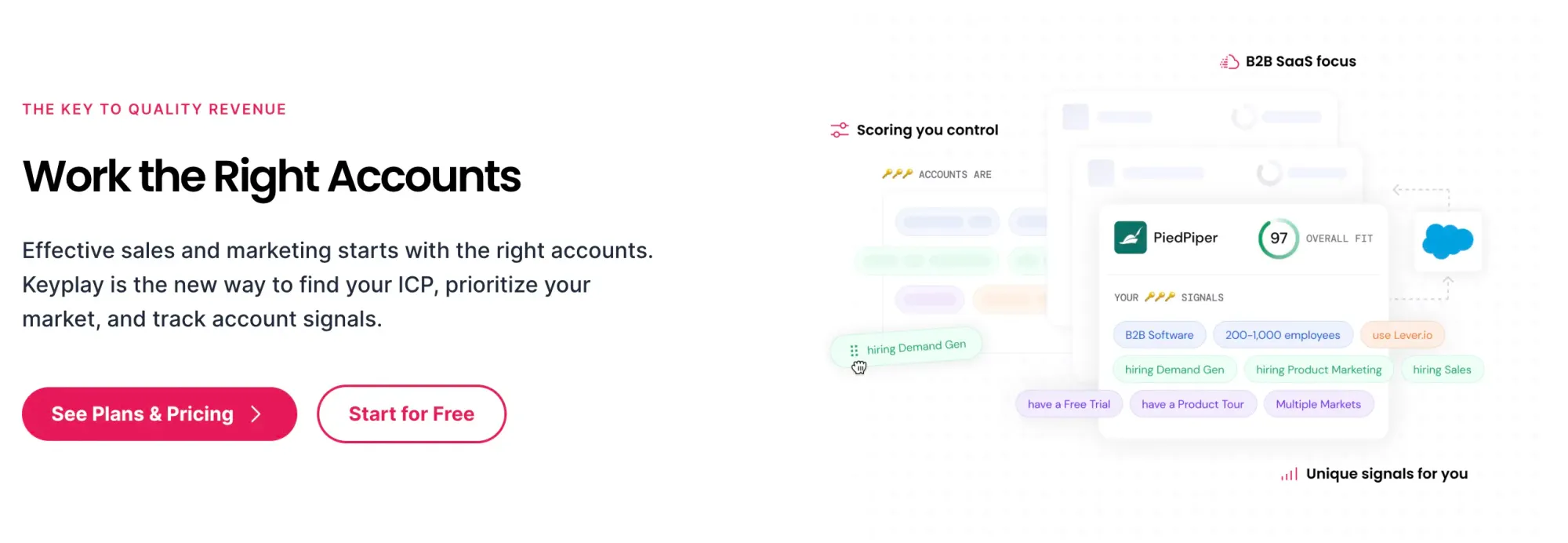
That even works when you need to change your ICP:
“We’ve worked with customers who’ve redefined their ICP or completely pivoted their product strategy. Whether it’s a product pivot or GTM shift (up-market, down-market, new segments), these are important moments. They either align you with the market or leave you behind. We’ve seen this happen when companies gain new insights, face new competition, or shift their internal focus,” says Adam Schoenfeld, Keyplay founder. “For growing startups, this is commonplace. Fast growth means your GTM strategy can’t stay static. That’s where many go wrong with ICP marketing – they treat their ICP as a one-time project. They define it one, build a list, and call it “done.” It’s not. It’s a program that needs continuous refinement and iteration.”
But what do you do with all that data?
Like Keyplay, Myko AI also allows you to keep track of your data to stay adaptable, and then derive actual insights from them. RevOps can take a long time to pull reports and make them digestible for salespeople because no one wants to look at raw data when they could be looking at a pretty graph.
This lets companies take advantage of the data that they already have instead of overhauling an entire system or looking under proverbial rocks to understand their own sales cycle.
Make your CRM data finally useful — with Myko AI
Myko is a CRM insights tool that allows you to update CRM data from a comms tool like Slack or Teams and derive otherwise unfindable insights on the sales and customer success motions. They have also launched an assistant that can help with meeting prep, researching prospects, and collating information from multiple websites, saving reps a ton of time in personalization and trying to understand their prospects before getting on a call.
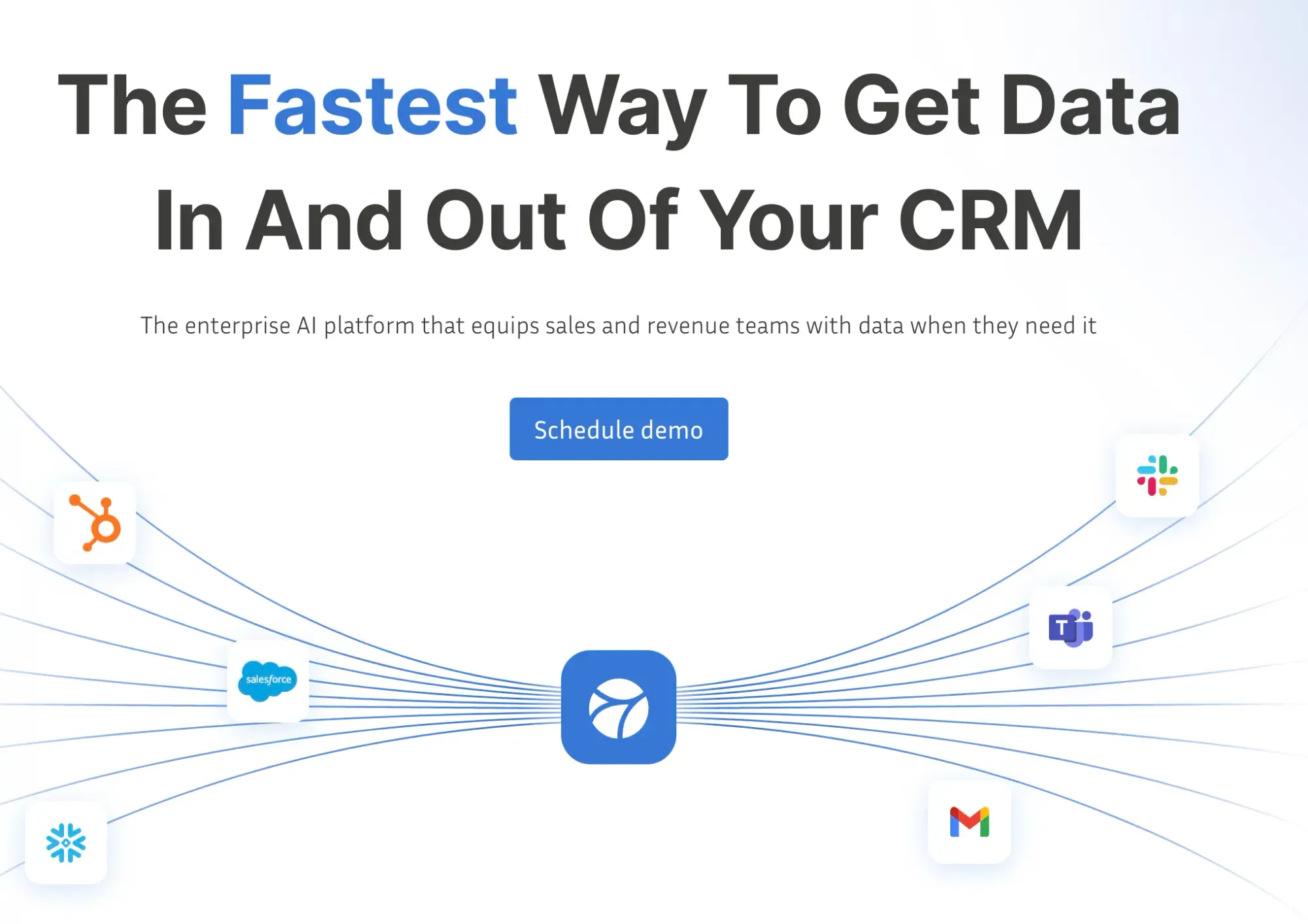
Myko AI’s founder Trevor Lee shared that he “use(s) the assistant for ALL of my meeting prep. As an example, for every calendar invite I have, I run a set of things I would like the assistant to prepare and research based on who I am meeting with. This can look up what podcast appearances a sales leader was on, what types of jobs a company is hiring for, relevant key stakeholders that are new to the company, any relevant news or fundraise announcements. Everything as a rep that I used to do manually to prepare - we have fully automated with the assistant.” To that end, Myko can let reps actually focus on asking the right questions instead of looking for CRM data.
Trevor lets the personalization the assistant provides speak for itself - “the most important thing is just asking the right questions. People will tell you what they care about and what their problems are. But you typically have to dig a couple layers down to see what they really care about and what moves the needle.”
How Unify lets you, well, unify your GTM
To ask the right questions, first you need to actually find the right data. Unify is a GTM tool that does exactly - and combines it in one convenient place to run “plays”.
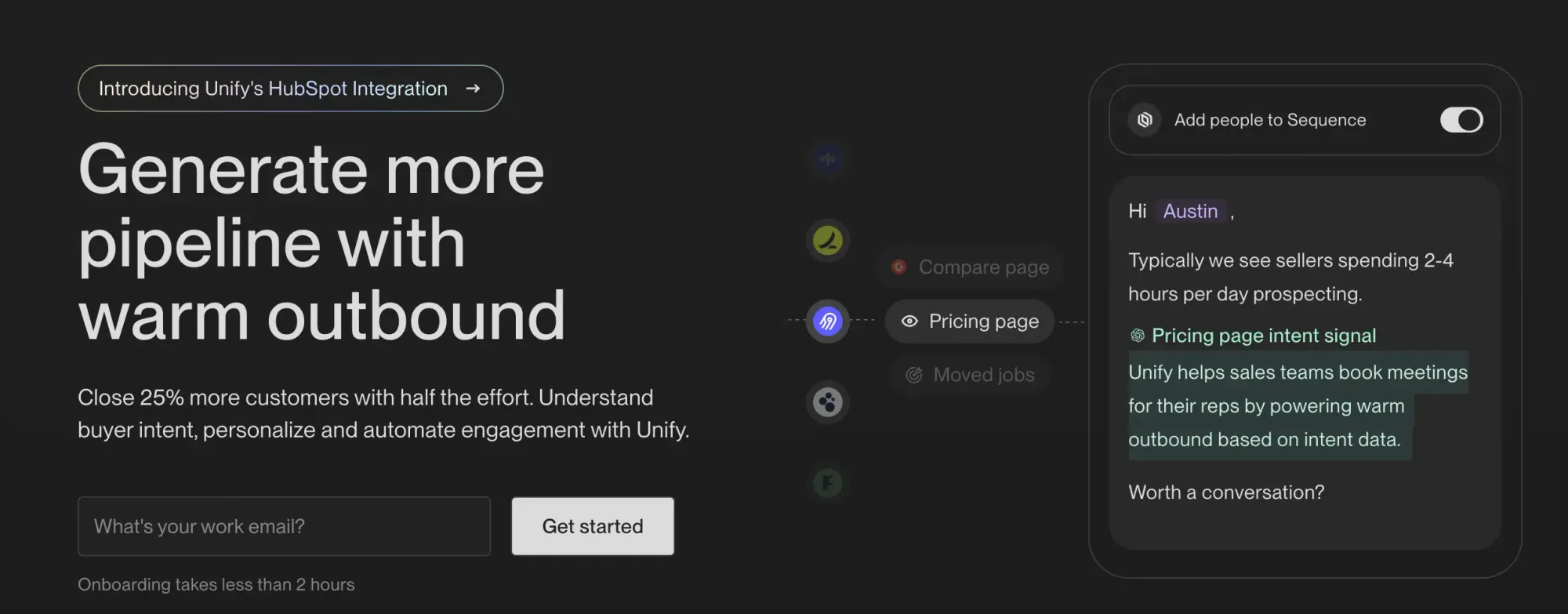
These allow you to not only prospect and reach out based on triggers, but also file away your data in an appropriate way. Unify integrates with data providers like 6Sense, G2, and Clearbit that allow for customers to access intent data and then build plays on top of it. An example of that is sending an email to a target account after someone browsing anonymously from that company looked at your website or automating outbound to a list of prospects who looked at your LinkedIn profile.
Unify’s growth team uses their own product with an autonomous outbound team that works almost solely off of plays and actually works more efficiently for them than traditional outbound: “We have a traditional outbound team and more of an automated outbound team. The traditional outbound team is run by your traditional sellers who pick up the phone, they send LinkedIn messages, they send emails, etc. That still works for us really well. What we’ve done is supplement traditional outbound with a growth team that does automated or scaled outbound and that’s worked really really well for us as well - it’s a bigger channel than traditional outbound,” says Unify founder Austin Hughes. Having something that’s automated also helps create a rationale for how to treat certain situations.
Instead of needing days or weeks to run an experiment and Frankensteining all of the data together, Unify does everything from signal detection to sending emails under one roof. ”The reason why Unify being an all-in-one product is so important is that we cut down on speed to learning by like 95%. The fact that you can know the results from a play in Unify in a few minutes is completely differentiated from having to stitch together five different point solutions and having to spend all of your time on the actual ops work of standing those things up. With Unify, 95% of time is spent on new campaign building, while companies using our competitors spend 95% of time just getting the campaign to work.”
On top of creating a well-oiled outbound function, a lot of companies struggle to effectively handle inbound, which is often labeled as “low hanging fruit,” yet a lot of buyers don’t want to talk to sales.
How Default wants to make inbound easy again
Why should it take 2 discovery calls to schedule a demo and get pricing? This is worse when prospects aren't qualified and reps don't know if a person is real.
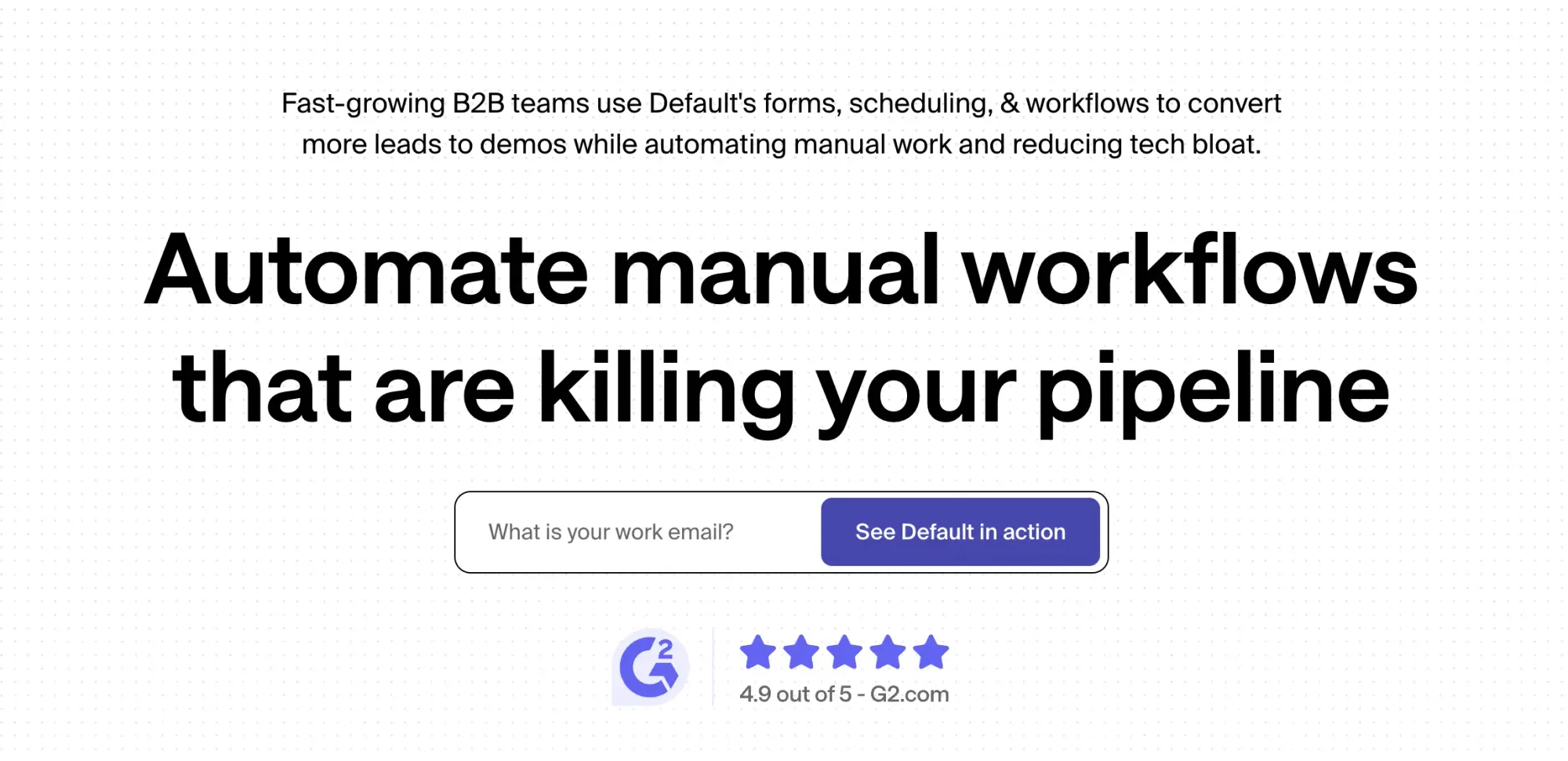
Default takes the guesswork out of scheduling inbound. It does everything from lead routing, lead qualification/enrichment, to demo booking and routing based on any set of criteria. It does what used to take multiple tools and custom integrations in a single SaaS tool.
This is another timeless startup strategy: Take something that should be easy and make it easy again.
“We think the future of inbound looks less like reps treating every inbound lead or a demo like a transactional relationship that can result in near-term revenue, and more like a consultative, buyer-first approach rooted in understanding where the buyer is in their journey. This is radically different from how many revenue teams think of inbound today, and doing it successfully means many teams have to rethink how they think about their tools, processes, workflows, and most importantly, their buyers,” Default founder Nico Ferreyra told us.
Because of this low-hanging-fruit mentality, revenue orgs often neglect inbound:
“[Inbound sales] also happens to be one of the most fragmented and overlooked types of sales at companies, especially in a macroeconomic environment like this one, where teams far and wide are pipeline-constrained due to cuts to marketing budgets over the last 2-3 years. The evidence for this is the complacency many growing sales orgs have towards implementing the right tooling and workflows to support their rebounding marketing spend,” notes Ferreyra.
But what happens once that demo is finally booked?
How Rattle keeps revenue leaders from going crazy
Rattle automates processes in revenue orgs and surfaces data that would otherwise languish in a dusty corner of the CRM.
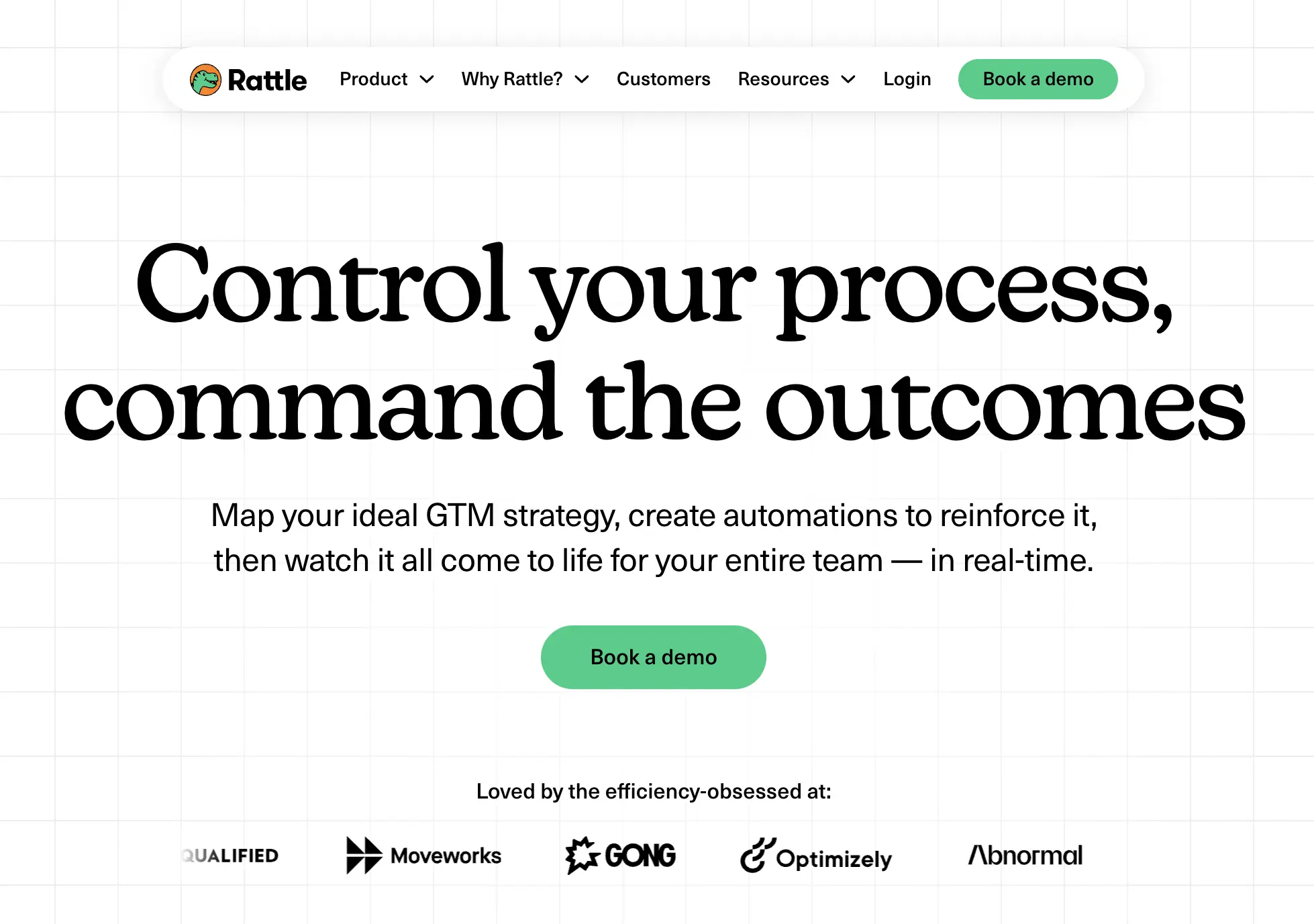
Like so many other startups, Rattle started with a founder solving their own problems. Rattle CEO Sahil had to regularly update key stakeholders on every deal.
When I spoke to Rattle's VP of Marketing Sara Kinsey, she shared founder Sahil’s pain points: “Sahil, (the CEO), was in a role where he needed to update the CRM. He would update but would still be asked by his manager about what happened in a certain conversation. He thought to himself - this is obnoxious and annoying. I can build something to solve this for me so that I don’t have to be annoyed by making that update in the CRM - these calls are recorded, this is in my emails - I shouldn’t have to go and log into Salesforce, make the update, and take a lot of time writing it out, and then have to go and repeat it to my manager.”
Sahil wasn't the only one annoyed by this (updating the CRM feels a bit like doing the dishes after a dinner party). His homegrown solution became Rattle–and has expanded in features, functionality, and use cases over the last three years.
With Rattle, your CRM stays updated without requiring RevOps or sales leaders to chase or nudge reps. Their automation workflows and AI-powered bi-directional sync between the CRM and Slack or Teams ensures that data is always accurate and up-to-date. This results in better data hygiene, improved reporting and insights, process adherence, and more reliable forecasts.
It also simplifies closing a deal: Instead of waiting until the last minute to bring in VPs or engineers, Rattle’s Deal Rooms and workflows bring them in ahead of time so they have visibility when they need it.
Go-to-market is changing... but how?
All of these startups show that GTM is changing. One reason is that it's broken, another is that AI is coming for everything, including sales. And it could make sales both more effective and a better experience for buyers:
"AI - we believe - is a good way of doing that and a good technology for sifting down the noise if somebody wants to. It's also just not a good experience for the buyer, and our perspective is that AI should be used to weed out the people that shouldn't be reached out to and then also make those communications to the right people just that much more thoughtful and effective. The hope is that over time, we actually start driving away some of this spray and pray outreach that hasn't been effective and has filled up inboxes” notes Unify’s Hughes.
AI isn’t only changing the outbound/personalization landscape. It also prevails in all of these sales/RevOps solutions. The key takeaway is that you need data if you want to be good at reaching people from ICP identification to close.
Secondly, parsing through data is no longer a task that should fall on the individual, and should instead be outsourced to a tool that moves faster and can pivot with an organization, like the five above. Closing as we know it doesn’t work anymore - “Gone are the days where people will pay for tools that they think are “cool” but don’t really need,” mentioned Myko’s Trevor Lee.
There are a lot of product lessons from these founders. We asked them exactly why they wanted to solve these problems:
Nico Ferreyra, Default:
Nico’s thought process behind building a tool like Default was that they wanted to build a better CRM - the CRM space is not small and already crowded by well-established players like Salesforce and Hubspot that people find too hard to move away from. Instead, they decided on the following approach:
1. Save customers time and money by vertically integrating the fragmented inbound cost center (forms, enrichment, scheduling, routing, workflow automation).
2. Become the default (no pun intended) system of record and orchestration layer for the inbound funnel, and keep building a deeper and deeper data model.
3. Play nicely with everyone outside of inbound by investing in integrations with the most popular systems our customers use.
4. Continue vertically integrating, and pass cost savings on better integration and software consolidation along to customers. Make money on NRR via more seats and cross-sells.
This is the game plan.
Adam Schoenfeld, Keyplay:
Yes, we did think about other applications in the early days. Market intel, sizing, and strategy support were all on the table. As data nerds, being in the “insights” business was appealing – especially since we’d been diving deep into marketing analysis with PeerSignal.org (and still do today). Some customers use Keyplay as an input for GTM strategy, but it’s a secondary use case.
Ultimately, we chose to focus on more operational use cases: account selection, territory planning, account list building, and demand gen. These areas are where the rubber meets the road with ICP Marketing. By helping our customers build a modern ICP program, we could drive real impact on pipeline and revenue. It’s not just about market theory, but who you should focus on to grow faster and more efficiently. With a clear, dynamic ICP model, everything else falls into place.
=
Even if you’re not concerned with the sales cycle, sales affects every corner of a business. The reason why GTM annoys so many people is that we’re they’re operating on outdated assumptions, but the sands under them have shifted. As meta as it sounds, these companies are the perfect example of building something for themselves and using that as a product lesson to continue to change the industry.
Inboxes are crowded and people are annoyed by bad outreach - helped by companies like Unify.
No one knows who to reach out to and why - solved by companies like Default, Unify, and Keyplay.
Internal data is confusing and hard to access, making data-driven decision-making harder - solved by Myko and Rattle.
Why transforming GTM is a great opportunity
The startups we featured are changing sales. The trend here is similar to other disruptive startups: Make something frustrating easy (like Rattle and Default) or enable something previously impossible (like Myko, Keyplay and Unify).
If I would advise a product-minded founder anything after this article, it'd be this:
- Find something people are annoyed with. The current state of sales is a perfect example here.
- Build something "close to the money". Directly help your customer make money or save money. While these startups tackle the "make money" front, we tackle the "save money" front by deflecting support tickets.

















